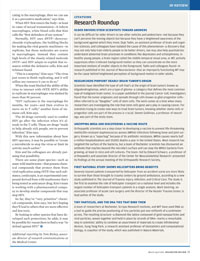In Review
Older Drivers Steer Scientists toward Answers
It can be difficult for older drivers to see other vehicles and pedestrians—not because they can’t perceive the moving objects but because they have a heightened awareness of the background against which they move. Duje Tadin, an assistant professor of brain and cognitive sciences, and colleagues have isolated the cause of this phenomenon—a discovery that may not only help train elderly people to be better drivers, but may also help psychiatrists understand abnormal brain processes in conditions like depression and schizophrenia. In healthy young people, a brain region called the middle temporal visual area, or MT, actively suppresses often irrelevant background motion so they can concentrate on the more important motions of smaller objects in the foreground. Tadin and colleagues found—in research published in the Journal of Neuroscience—that an improperly functioning MT may be the cause behind heightened perception of background motion in older adults.
Researchers Pinpoint Deadly Brain Tumor’s Origin
Scientists have identified the type of cell that’s at the origin of brain tumors known as oligodendrogliomas, which are a type of glioma—a category that defines the most common type of malignant brain tumor. In a paper published in the journal Cancer Cell, investigators found that the tumor originates and spreads through cells known as glial progenitor cells—often referred to as “daughter” cells of stem cells. The work comes at a time when many researchers are investigating the role that stem cells gone awry play in causing cancer. For scientists trying to create new ways to treat brain tumors, knowing whether stems cells or progenitor cells are part of the process is crucial. Steven Goldman, a professor of neurology, was part of the study team.
Unzipping MRSA and Discovering a Vaccine Route
Orthopaedic scientists are a step closer to developing a vaccine to prevent life-threatening methicillin-resistant staphylococcus aureus (MRSA) infections following bone and joint surgery. Known as a “superbug” because of its antibiotic resistance, MRSA causes nearly half a million hospitalizations and 19,000 deaths a year in the United States. Most research has targeted the surface of the bacteria, but a team of Rochester scientists has discovered an antibody that reaches beyond the microbe’s surface and can stop the MRSA bacteria from growing, at least in mice and cell cultures. The team—led by Edward Schwarz, a professor of orthopaedics and associate director of the Center for Musculoskeletal Research—presented its findings at the annual meeting of the Orthopaedic Research Society.
First National Study Shows Helicopters Bring Benefits
Severely injured patients transported by helicopter from an accident scene are more likely to survive than those brought to trauma centers by ground ambulance, according to a new study published in The Journal of Trauma: Injury, Infection, and Critical Care. The study is the first to examine the role of helicopter transport on a national level and includes the largest number of helicopter-transport patients in a single analysis. Mark Gestring, an associate professor of acute care surgery and the director of the Kessler Trauma Center, is lead author of the study.
Tiny Particles, and the DNA Ties that Bind Them
A team of researchers at Rochester, Scripps Research Institute, and MIT have used DNA as a tool to guide the precise positioning of tiny particles just one-millionth of a centimeter across. The resulting structure—a diamond-like lattice composed of gold nanoparticles and viral particles, woven together and held in place by strands of DNA—marks a remarkable step in scientists’ ability to combine an assortment of materials to create infinitesimal devices. Sung Yong Park, a research assistant professor of biostatistics and computational biology, is coauthor of the study, which was published in Nature Materials.

